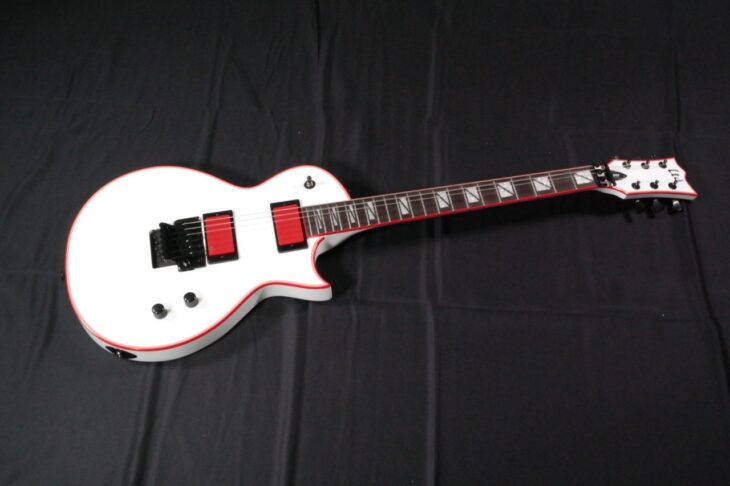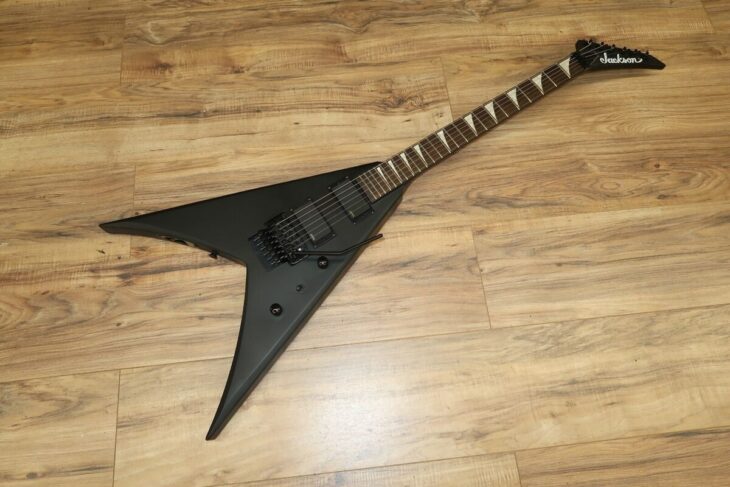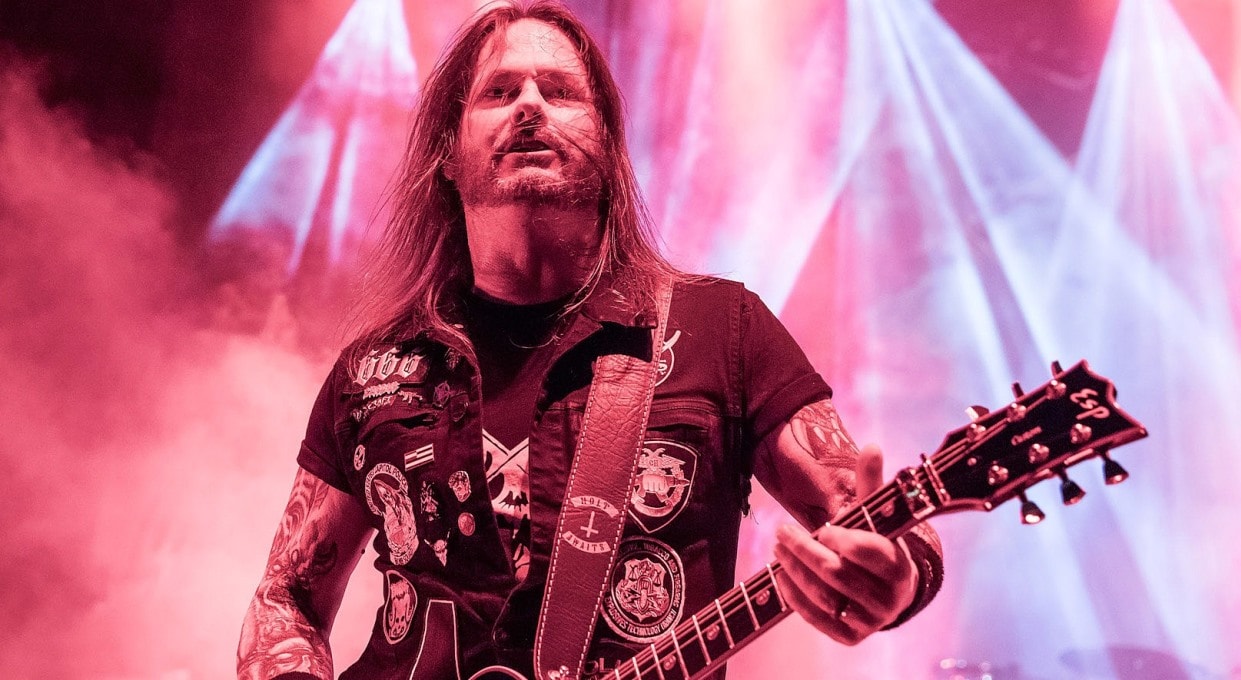Exodus’ uncompromising thrash metal has been a mainstay of headbangers’ tee shirts, car cassettes, and festival lineups for forty years now. Exodus was one of the foremost proponents of the high-speed aggressive style of metal that emerged out of San Francisco in the early 80s.
Dubbed “Bay Area Thrash,” the style was marked by breakneck tempos, aggressive vocals, and rapid-fire palm-muted riffs. Few guitarists epitomized this style quite like Gary Holt, the longest-serving member of Exodus, who also plays to this day with Slayer.
In this article, I’ll look at the key pieces of gear that thrash fans need to capture some of the Gary Holt Exodus tone, with particular emphasis on the tone from “The Toxic Waltz.”
Table of Contents
Gary Holt Guitars
In the 80s, like many of his contemporaries, Gary Holt was partial to hot-rodded Superstrat-style guitars. He’s used various guitars of this configuration over the years from Jackson, Ibanez, B.C. Rich, and Yamaha. Of late, Holt endorses Japanese-made ESP guitars.
One consistent feature on Holt’s guitars, however, has been his embrace of the very particular tone of EMG pickups. Holt has used high-output EMG active pickups, powered by an additional battery, for forty years now. He even has a signature set available through the legendary pickup manufacturer.
EMG pickups were a defining sound in thrash metal, so it’s no surprise that they’re a key feature for the Gary Holt tone. Holt’s signature ESP model comes with his EMGs, and Holt uses them live with Exodus and Slayer to this day.

The easiest recommendation to make for the Gary Holt tone is to play one of his signature guitars. He has a few on offer: there’s an asymmetrical Rhoads-style V, a Les Paul-style Eclipse, and at a much lower price point, the ESP LTD Eclipse.
The ESP LTD model does not come with EMG pickups, however, so you’d need to put these in as an aftermarket addition. The stock ESP-designed pickups don’t have the razor-sharp edge of genuine EMG active pickups.
Alternatively, you could look at Jackson guitars, such as the EMG-equipped King V.

There’s also a Charvel Superstrat-style guitar equipped with active pickups, although you’d need to install EMG pickups for that particular tone yourself.
The good news is that tonewoods and body shape are less important for the Holt tone than the pickups are. The overpowering high-gain sound of EMGs obscures most of the finer details of a guitar’s natural sound, so you can use any body shape and wood that you prefer.
Of course, playability, particularly for Gary Holt’s high-speed riffing, is a major factor, so I wouldn’t recommend a guitar that isn’t built for speed. Likewise, you’ll be playing with high levels of gain, so a solid-bodied guitar to minimize feedback is best.
Gary Holt Amps
These days, Gary Holt uses a variety of amplifiers and profiling technologies. He has wholeheartedly embraced the Kemper amp profiler, and with Slayer often uses high-gain modern Marshall amplifiers.
Holt has also used an ENGL Savage extensively both live and in the studio of late.
The classic Exodus tone, however, as with so many of Gary Holt’s 80s metal contemporaries, was a Marshall JCM800. Holt actually still uses his 800 to this day, albeit in conjunction with various other amplifiers.

You can get close to the Gary Holt Exodus tone through any of a few wallet-friendly amps.
The lower-powered 25-watt ENGL Fireball is one great option. Because it operates at a lower wattage, you can achieve a thick, saturated tone without cranking your volume and rattling the windows.
Alternatively, the Marshall Studio Classic combo is, for all intents and purposes, an 80s-style JCM800 in a smaller, more affordable box. The most useful feature here for Holt fans is its power switching capability, enabling you to reduce your wattage to a mere 5 watts, offering an even lower volume threshold for thrash-ready distorted tones.
Exodus Amp Settings
Gary Holt’s thick, powerful, distorted tone epitomizes all that is great about 80s thrash metal. This is a demanding, uncompromising tone that requires players to nail their muting and alternate picking technique lest the amp descends into squealing feedback.
The Exodus tone, to my ears, has always felt a little sharper and spikier than the “scooped” tone of other metal bands. I’ve based the below amp setting recommendations on that observation.
Master Volume: 8
If you have a master volume control, crank it. This is loud music.
Gain: 8
Turn the gain up nice and high. Not so far that it becomes mushy, but loud enough to compress and saturate your sound.
Bass: 4
You need to keep your low end minimal for this tone to avoid it becoming doomy or mushy.
Mids: 7
You need midrange articulation for this sound to really take off.
Treble: 8
With great distortion comes a natural lack of treble. Counteract this with a higher treble level than you’d normally employ.
Gary Holt Pedals
Like many guitar players, Gary Holt has played a variety of pedals over the years, often changing his setup between albums and tours. Holt once described his love of stompboxes as “like crack to me.”
While this isn’t a comprehensive list of every pedal Holt has ever used, I’m recommending pedals that I feel have been integral to his distinctive thrash metal tone.
Chief among these is some kind of overdrive or distortion. Holt has variously used Boss, Pigtronix, Maxon, and Ibanez overdrives over the years, and extended his collection to boutique and custom-made overdrives to boot.
For the most part, I’d recommend either a classic Tube Screamer or a Boss Super Overdrive. Holt has, over the years, used both the TS808 and TS9 models, which have distinct tonal characteristics. It’s up to you which sound you prefer. I’d recommend the 808 for Exodus material, as this was a commonly used pedal among San Francisco thrash bands of the era.

Another key piece of the Holt puzzle is a quality wah pedal. Gary Holt has used various signature model wahs over the years, mostly those bearing the signatures of his close guitar-playing friends.
One of Holt’s most enduring friendships is that with ex-Exodus axeman Kirk Hammett, who left the band to join Metallica in 1983. Accordingly, Holt has employed various bits of Hammett signature gear over the years, including Kirk’s signature model Cry Baby. You could also use the standard Cry Baby, but it doesn’t look quite as cool as the Kirk Hammett model.

Occasionally, Holt will thicken up his tone, whether dirty or clean, with some chorus. He has mostly favored the TC Electronic Corona Chorus. This is a sometimes-on effect mostly used for flavoring, rather than an always-on integral piece of his tone.
Final Word
Gary Holt’s tone, as heard on every Exodus album, is, in my opinion, one of the best examples of the aggressive, powerful tone of thrash metal playing. It’s well-suited to rapidfire palm mutes and screaming leads. I’d use this tone for just about any kind of thrash metal playing, not just for Exodus.
I’d happily while away hours running through my favorite Metallica and Testament riffs with this tone. All you need is a great guitar equipped with EMG pickups, a high-powered amp, and an overdrive to kick on for any lead breaks.

